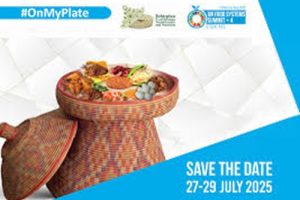
The three leading sectors of the economy such as agriculture, manufacturing industry and services play pivotal role for achieving growth. Agriculture has created employment opportunities to almost 80% of the labor force, contributed for foreign exchange earnings, and supplied food to the market at least at subsistence level and raw materials to the manufacturing industry. Tourism, hotel and trade are categorized as service sectors also play crucial role in creating job and income generation.
The Ethiopian Herald made a stay with Solomon Zegeye, an economist working as a consultant for various firms. As to him, currently, agriculture contributes 45% to the nation’s Gross Domestic Production (GDP). For the double digit economic growth registered in the past two successive decades, the sector played significant role and the utilization of modern agricultural inputs such as fertilizer, pesticides and herbicides have attributed to increase production and productivity.
He also said that even though agriculture is the main stay of the nation’s economy, its contribution to the GDP is declining and this indicates that the nation is experiencing structural change and the contribution of manufacturing and service sectors to the GDP is growing.
Textile and garment, leather and shoe and agro business are the backbone of the Manufacturing sector. The textile industry has essentially created job opportunity to thousands but it is also dependent on the importation of cotton. It supplies its products mainly to the foreign markets and garners foreign currency.
The leather and leather products’ sub sector garners hard currency by exporting its products to foreign markets in addition to creating job. The agro business sub sector also plays key role in processing agricultural products and producing food supplied to local market. Although it has a potential in transforming the economy to the higher productivity rate, it is still in its infancy. The sector is dependent on imported inputs and spare parts, faces power interruption and other shortcomings.
Currently, due to foreign currency crunch in the banks, opening Letter of Credit (LC) for securing hard currency is too much cumbersome and takes months. As a result, firms are forced to reduce their production volume.
The service sector mostly characterized by tourism, hotels and entertainment is flourishing in urban centers. It created job opportunities for tens of thousands and heavily utilizes locally produced agricultural products and created link with the other sectors. Tourism is one of the service sectors which play pivotal role in job creation and foreign currency earnings.
The government is working aggressively on the expansion of lodges and parks which can attract local and foreign tourists by allocating huge amount of budget. The availing of parks and animals’ zoo in the city further stimulates the sector.
As to Solomon, the Growth and Transformation program which was implemented earlier to the current reformist government had its own weakness because it had tried to implement an imported economic plan ignoring the nation’s context. As a result, it was unable to achieve structural change which was targeted to be achieved by 2020.
As to him, the 10 years perspective economic development plan introduced by the current government goes in line with the reality on the ground and has a potential to attain structural change. It is prepared based on the actor institutions implementing capacity in a bottom up approach.
To lay ground for industrialization, the agriculture sector must ensure the nation’s food self- sufficiency so that, citizens productivity and creativity will be enhanced which in turn drive the economy on the right track. But if it is not, the nation will continue to import food and other agricultural products and the nation will continue to spend its meager foreign currency resource for the importation of agricultural products.
The expansion of manufacturing changes the economy driven by low economic performance in to the higher productivity, creates job opportunities, boosts export, support import substitution, creates linkage with the agriculture, and attracts both local and foreign investment.
However, to attain sustainable development, the state of the nation’s macro economy should be healthy. Some of the indicators of the macro economic situation are total employment rate, national fiscal policy, government revenue and expenditure. Money supply, interest rate and the nation’s foreign currency earnings serve as the backbone of the economy.
The fiscal aspect of the nation also can be mentioned as a major indicator of the macro economic status of the country. Whether the total budget of the country is covered by local sources or not or part of it is covered by foreign loan or aid, determines the healthiness of the economy. Whether the nation is financing its mega projects by local sources or not, it defines the characteristics of the macro economy.
As to Solomon, policy makers, before talking about economic development, should think that how could they feed the population. When there are shortfalls in meeting the basic needs, aspiring big things remains a day dreaming.
When the food price becomes lower, citizens’ income will rise. For instance, a person who earns 10 thousand Birr per month and spends five thousand for house rent and the rest four thousand for food and other expenses, we can say that he lives in a hand to mouth income brackets. In such a situation, the society will be vulnerable to various economic shocks. Therefore, to stabilize the living situation of the society, agricultural productivity must be increased.
However, as mentioned above, though agriculture is the main stay of the nation’s economy, it is subsistence, vulnerable to extreme climate variation, and land fragmentation due to population pressure. In addition to these, as farmers lack sense of ownership of land, raising productivity becomes a challenge.
Asked whether there are possibilities to overcome the aforementioned problems and uplifting the farming sector, Solomon said that despite the sector is subsistence, adopting technology and utilizing more agricultural inputs can be taken as a way out.
He further said that countries which have predominantly arid areas proved the possibility of raising agricultural productivity through adopting better technology. But as to Solomon, utilizing cutting edge technology requires huge amount of money which Ethiopia ill affords.
To achieve structural change, planning strategy to shift the stranded labor force in the rural part to the urban center and get employment in manufacturing and service sectors is essential. Moving the labor force from farming to none farming also helps to establish extensive farm which utilizes modern farm inputs that helps attaining raising productivity.
Currently, the practicing of farming in a collective way by small holder farmers proved the possibility of improving productivity.
As to Solomon, in Ethiopia, there is abundant natural resource which can be used as input to agriculture but due to the absence of finance, technology and skill, the nation is unable to tap the resources. Thus, the sector utilizes less inputs with les output. As a result, it has remained subsistence.
If the situation is changed to the better, the probability of ensuring food security in the near future will be high. To that end, exploring and exploiting the water resources of the country is essential. The government’s endeavor in this regard is appreciable.
According to the report from Ministry of Irrigation and Law Land Areas Development, Ethiopia utilized only five percent of its water resources for irrigation and the arable land that can be used for extensive farming particularly found in its law land parts remains idle.
Modern irrigation farms were introduced in Ethiopia by Netherlands Company in 1960s. Large farms were cultivated in the upper, middle and lower Awash River valley. Sugar cane was used as inputs for sugar factory located in Mattahara town of Oromia region which has still continued its production. In the lower Awash River valley, cotton plantation was underway and the product was supplied to local and export market but now it is ceased to exist. Large scale farms also were flourished in the north western parts of the country in the areas of Humera and Mattama towns since 1960. The farms produce oil seeds and supply their products to local and foreign markets.
The dry season wheat farm is cultivated by small scale farmers through clustering system could bring tremendous results in meeting the local wheat demand. Some of the products also are exported to the neighboring countries and support the nation’s hard currency earning capacity.
Such achievement can be taken as a showcase that the nation has the potential to raise agricultural productivity and ensuring food security.
BY ABEBE WOLDEGIORGIS
THE ETHIOPIAN HERALD FRIDAY 1 MARCH 2024





